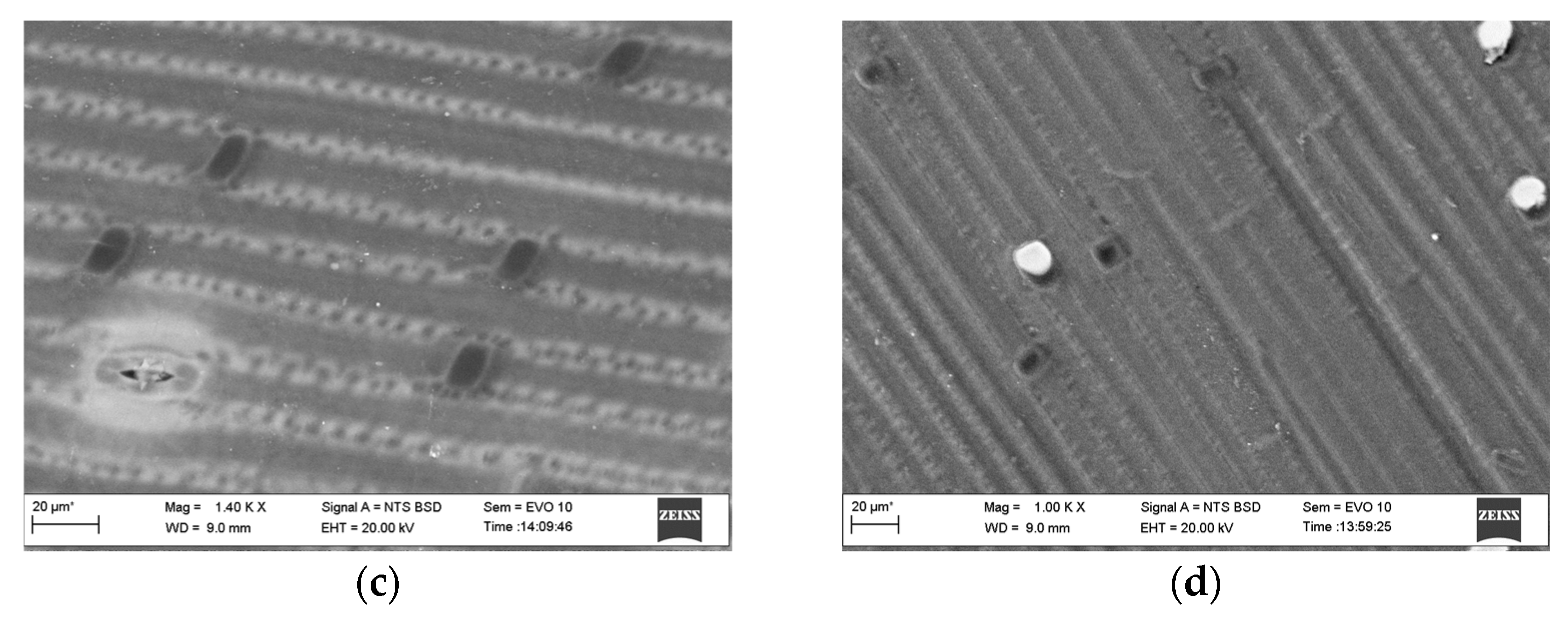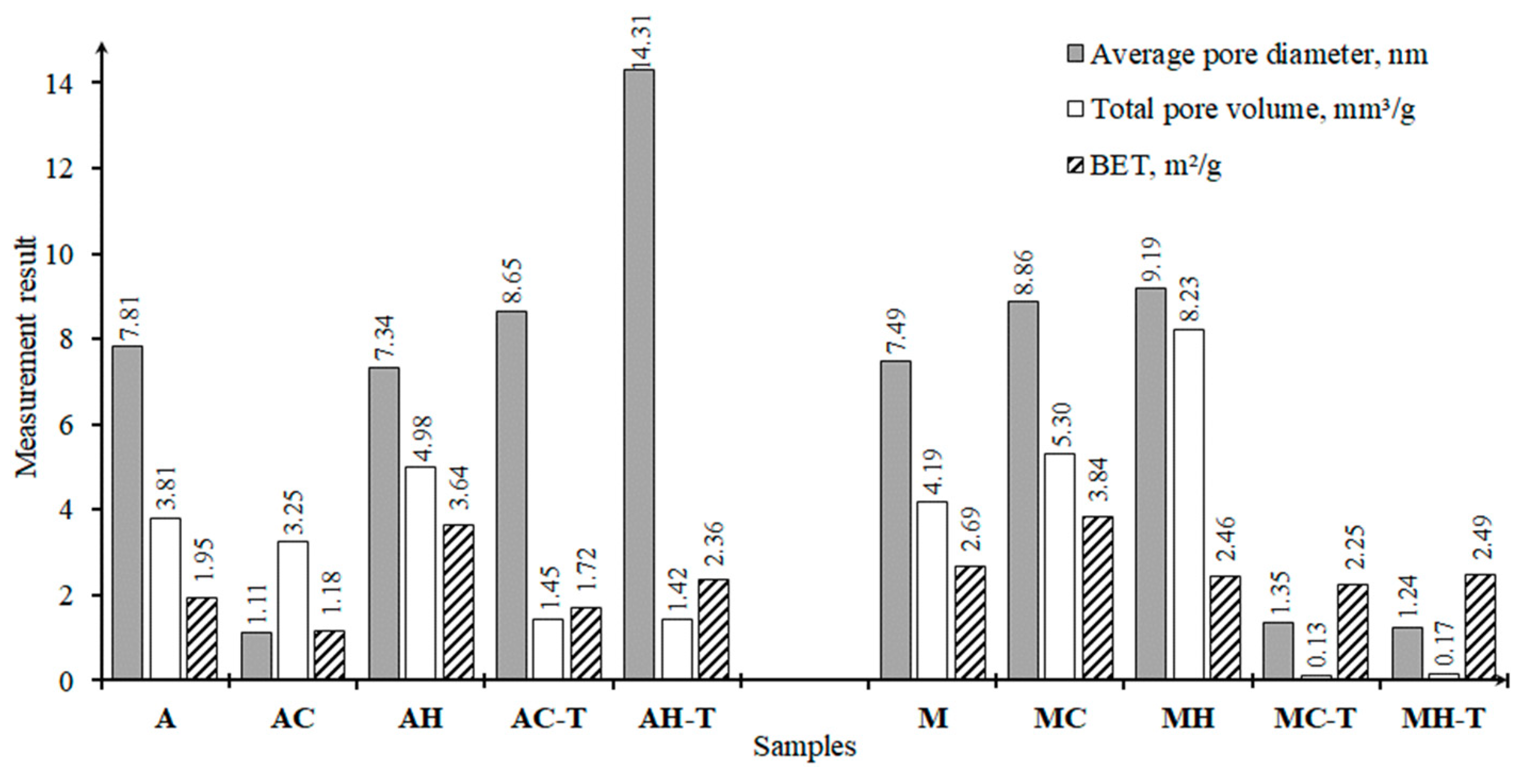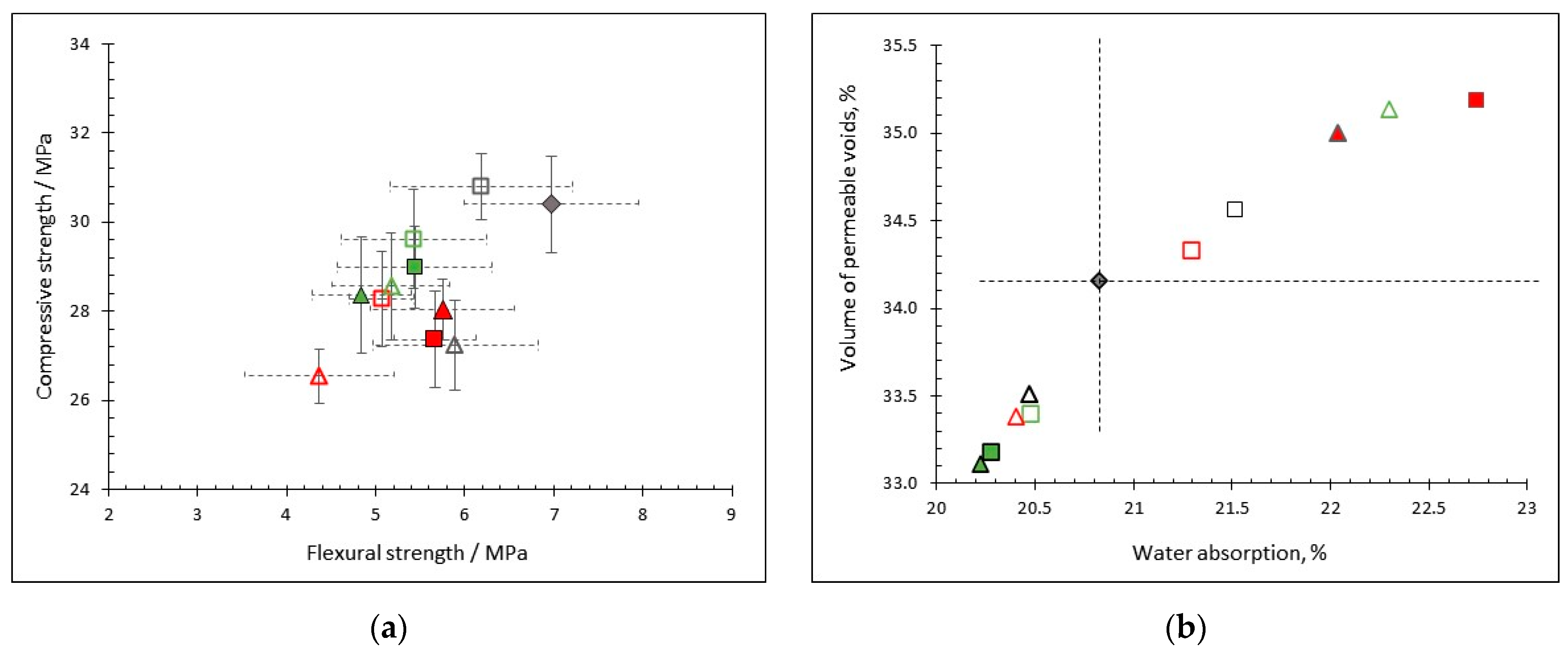Surface-Modified Wheat Straw for the Production of Cement-Free Geopolymer Composite: Effects of Wheat Variety and Pre-Treatment Method
Abstract
:1. Introduction
2. Materials and Methods
2.1. Raw Materials
2.1.1. Biomass Samples
2.1.2. Geopolymer Material
2.1.3. Chemical Treatment
2.2. Wheat Pre-Treatment and Modification Procedure
2.3. Geopolymer Samples’ Production and Testing
2.4. Characterization
3. Results
3.1. Characterization of Wheat Straw
3.2. Characterization of Geopolymers with Wheat Straw
4. Discussion
5. Conclusions
Author Contributions
Funding
Data Availability Statement
Acknowledgments
Conflicts of Interest
References
- Farhan, K.Z.; Johari, M.A.M.; Demirboğa, R. Assessment of important parameters involved in the synthesis of geopolymer composites: A review. Constr. Build. Mater. 2020, 264, 120276. [Google Scholar] [CrossRef]
- Sambucci, M.; Sibai, A.; Valente, M. Recent Advances in Geopolymer Technology. A Potential Eco-Friendly Solution in the Construction Materials Industry: A Review. J. Compos. Sci. 2021, 5, 109. [Google Scholar] [CrossRef]
- Walkley, B. Geopolymers. In Encyclopedia of Engineering Geology; Springer: Cham, Switzerland, 2018; pp. 1–2. [Google Scholar] [CrossRef]
- da Silva Alves, L.C.; dos Reis Ferreira, R.A.; Bellini Machado, L.; de Castro Motta, L.A. Optimization of metakaolin-based geopolymer reinforced with sisal fibers using response surface methology. Ind. Crops Prod. 2019, 139, 111551. [Google Scholar] [CrossRef]
- Walbrück, K.; Drewler, L.; Witzleben, S.; Stephan, D. Factors influencing thermal conductivity and compressive strength of natural fiber-reinforced geopolymer foams. Open Ceram. 2021, 5, 100065. [Google Scholar] [CrossRef]
- Koh, C.H.; Kraniotis, D. A review of material properties and performance of straw bale as building material. Constr. Build. Mater. 2020, 259, 120385. [Google Scholar] [CrossRef]
- Koh, C.; Gauvin, F.; Schollbach, K.; Brouwers, H. Upcycling wheat and barley straws into sustainable thermal insulation: Assessment and treatment for durability. Resour. Conserv. Recycl. 2023, 198, 107161. [Google Scholar] [CrossRef]
- Fan, Q.; Han, G.; Cheng, W.; Tian, H.; Wang, D.; Xuan, L. Effect of intercalation structure of organo-modified montmorillonite/polylactic acid on wheat straw fiber/polylactic acid composites. Polymers 2018, 10, 896. [Google Scholar] [CrossRef] [PubMed]
- Jiang, D.; Lv, S.; Jiang, D.; Xu, H.; Kang, H.; Song, X.; He, S. Effect of modification methods on water absorption and strength of wheat straw fiber and its cement-based composites. J. Build. Eng. 2023, 71, 106466. [Google Scholar] [CrossRef]
- Zou, S.; Li, H.; Liu, L.; Wang, S.; Zhang, X.; Zhang, G. Experimental study on fire resistance improvement of wheat straw composite insulation materials for buildings. J. Build. Eng. 2021, 43, 103172. [Google Scholar] [CrossRef]
- Yilma, W.M.; Singh, B.; Asrat, G.; Hossain, N. Taguchi Method Optimization of Water Absorption Behavior by Wheat Straw-Basalt Hybrid Brake Pad Composite. J. Compos. Sci. 2023, 7, 62. [Google Scholar] [CrossRef]
- Ghaffar, S.H.; Fan, M. An aggregated understanding of physicochemical properties and surface functionalities of wheat straw node and internode. Ind. Crops Prod. 2017, 95, 207–215. [Google Scholar] [CrossRef]
- Jiang, J.; Fu, J.; An, N.; Zhang, Y.; Chen, X.; Wang, L. Rapid and effective molten oxalic acid dihydrate pretreatment to enhance enzymatic saccharification for biohydrogen production by efficient coextraction of lignin and hemicellulose in wheat straw. Chem. Eng. J. 2023, 475, 146422. [Google Scholar] [CrossRef]
- Gaudino, E.C.; Grillo, G.; Tabasso, S.; Stevanato, L.; Cravotto, G.; Marjamaa, K.; Pihlajaniemi, V.; Koivula, A.; Aro, N.; Uusitalo, J.; et al. Optimization of ultrasound pretreatment and enzymatic hydrolysis of wheat straw: From lab to semi-industrial scale. J. Clean. Prod. 2022, 380, 134897. [Google Scholar] [CrossRef]
- Fougere, D.; Nanda, S.; Clarke, K.; Kozinski, J.A.; Li, K. Effect of acidic pretreatment on the chemistry and distribution of lignin in aspen wood and wheat straw substrates. Biomass Bioenergy 2016, 91, 56–68. [Google Scholar] [CrossRef]
- Deng, Y.; Qiu, Y.; Yao, Y.; Ayiania, M.; Davaritouchaee, M. Weak-base pretreatment to increase biomethane production from wheat straw. Environ. Sci. Pollut. Res. 2020, 27, 37989–38003. [Google Scholar] [CrossRef] [PubMed]
- Pan, N.; Jiang, B.; Hu, J.; Huang, M.; He, J.; Jiang, Q.; Zhao, L.; Shen, F.; Tian, D. The coupling effects between acid-catalyzed hydrothermal pretreatment and acidic/alkaline deep eutectic solvent extraction for wheat straw fractionation. Bioresour. Technol. 2023, 386, 129579. [Google Scholar] [CrossRef] [PubMed]
- Chougan, M.; Ghaffar, S.H.; Al-Kheetan, M.J.; Gecevicius, M. Wheat straw pre-treatments using eco-friendly strategies for enhancing the tensile properties of bio-based polylactic acid composites. Ind. Crops Prod. 2020, 155, 112836. [Google Scholar] [CrossRef]
- Sharifi, A.; Mousavi, S.R.; Ghanemi, R.; Mohtaramzadeh, Z.; Asheghi, R.; Mohammadi-Roshandeh, J.; Khonakdar, H.A.; Hemmati, F. Extruded biocomposite films based on poly(lactic acid)/chemically-modified agricultural waste: Tailoring interface to enhance performance. Int. J. Biol. Macromol. 2023, 233, 123517. [Google Scholar] [CrossRef]
- JTong, J.; Wang, X.; Kuai, B.; Gao, J.; Zhang, Y.; Huang, Z.; Cai, L. Development of transparent composites using wheat straw fibers for light-transmitting building applications. Ind. Crops Prod. 2021, 170, 113685. [Google Scholar] [CrossRef]
- Jiang, D.; Jiang, D.; Lv, S.; Cui, S.; Sun, S.; Song, X.; He, S.; Zhang, J. Effect of modified wheat straw fiber on properties of fiber cement-based composites at high temperatures. J. Mater. Res. Technol. 2021, 14, 2039–2060. [Google Scholar] [CrossRef]
- Jiang, D.; An, P.; Cui, S.; Xu, F.; Tuo, T.; Zhang, J.; Jiang, H. Effect of leaf fiber modification methods on mechanical and heat-insulating properties of leaf fiber cement-based composite materials. J. Build. Eng. 2018, 19, 573–583. [Google Scholar] [CrossRef]
- Chougan, M.; Ghaffar, S.H.; Sikora, P.; Mijowska, E.; Kukułka, W.; Stephan, D. Boosting Portland cement-free composite performance via alkali-activation and reinforcement with pre-treated functionalised wheat straw. Ind. Crops Prod. 2022, 178, 114648. [Google Scholar] [CrossRef]
- Song, W.; Yang, Z.; Zhang, S.; Fei, B.; Zhao, R. Properties enhancement of poly(β-hydroxybutyrate) biocomposites by incorporating surface-modified wheat straw flour: Effect of pretreatment methods. Int. J. Biol. Macromol. 2023, 232, 123456. [Google Scholar] [CrossRef] [PubMed]
- Chen, K.; Li, P.; Li, X.; Liao, C.; Li, X.; Zuo, Y. Effect of silane coupling agent on compatibility interface and properties of wheat straw/polylactic acid composites. Int. J. Biol. Macromol. 2021, 182, 2108–2116. [Google Scholar] [CrossRef] [PubMed]
- Hussain, A.; Calabria-Holley, J.; Jiang, Y.; Lawrence, M. Modification of hemp shiv properties using water-repellent sol–gel coatings. J. Sol-Gel Sci. Technol. 2018, 86, 187–197. [Google Scholar] [CrossRef] [PubMed]
- Wang, H.; Zhen, Z.; Yao, S.; Li, S. Synthesis of high acid-resistant ultramarine blue pigment through coal gangue, industrial zeolite waste and corn straw waste recycling. Resour. Chem. Mater. 2022, 1, 137–145. [Google Scholar] [CrossRef]
- Le Gouis, J.; Oury, F.-X.; Charmet, G. How changes in climate and agricultural practices influenced wheat production in Western Europe. J. Cereal Sci. 2020, 93, 102960. [Google Scholar] [CrossRef]
- Toleikiene, M.; Zvirdauskiene, R.; Suproniene, S.; Arlauskiene, A.; Brophy, C.; Kadziuliene, Z. Soil microbial functional diversity responds to plant-based organic fertlisers depending on the group of carbon sources. Pol. J. Environ. Stud. 2021, 30, 2755–2768. [Google Scholar] [CrossRef]
- Toleikienė, M.; Arlauskienė, A.; Šarūnaitė, L.; Šidlauskaitė, G.; Kadžiulienė, Ž. The effect of plant-based organic fertilisers on the yield and nitrogen utilization of spring cereals in the organic cropping system. Zemdirbyste 2020, 107, 17–24. [Google Scholar] [CrossRef]
- Ahmad, M.H.; Nache, M.; Waffenschmidt, S.; Hitzmann, B. Characterization of farinographic kneading process for different types of wheat flours using fluorescence spectroscopy and chemometrics. Food Control. 2016, 66, 44–52. [Google Scholar] [CrossRef]
- Ghaffar, S.H.; Fan, M.; Zhou, Y.; Abo Madyan, O. Detailed Analysis of Wheat Straw Node and Internode for Their Prospective Efficient Utilization. J. Agric. Food Chem. 2017, 65, 9069–9077. [Google Scholar] [CrossRef] [PubMed]
- Ghaffar, S.H.; Fan, M. Differential behaviour of nodes and internodes of wheat straw with various pre-treatments. Biomass Bioenergy 2015, 83, 373–382. [Google Scholar] [CrossRef]
- Kalpokaitė-Dičkuvienė, R.; Lukošiūtė, I.; Brinkienė, K.; Striūgas, N.; Baltušnikas, A.; Lukauskaitė, R.; Čėsnienė, J. Utilization of sewage sludge-biomass gasification residue in cement-based materials: Effect of pozzolant type. Environ. Technol. 2017, 39, 2937–2950. [Google Scholar] [CrossRef] [PubMed]
- Kalpokaitė-Dičkuvienė, R.; Baltušnikas, A.; Levinskas, R.; Čėsnienė, J. Incinerator residual ash—Metakaolin blended cements: Effect on cement hydration and properties. Constr. Build. Mater. 2019, 206, 297–306. [Google Scholar] [CrossRef]
- Kalpokaitė-Dičkuvienė, R.; Lukošiūtė, S.I.; Baltušnikas, A.; Čėsnienė, J. Structural observation of cement paste modified with hydrophobic organoclay. Constr. Build. Mater. 2020, 272, 121931. [Google Scholar] [CrossRef]
- Thommes, M.; Cychosz, K.A. Physical adsorption characterization of nanoporous materials: Progress and challenges. Adsorption 2014, 20, 233–250. [Google Scholar] [CrossRef]
- Zhang, L.; Larsson, A.; Moldin, A.; Edlund, U. Comparison of lignin distribution, structure, and morphology in wheat straw and wood. Ind. Crops Prod. 2022, 187, 115432. [Google Scholar] [CrossRef]
- Wang, Y.; Ji, X.-X.; Liu, S.; Tian, Z.; Si, C.; Wang, R.; Yang, G.; Wang, D. Effects of two different enzyme treatments on the microstructure of outer surface of wheat straw. Adv. Compos. Hybrid Mater. 2022, 5, 934–947. [Google Scholar] [CrossRef]
- Nath, B.; Chen, G.; Bowtell, L.; Graham, E. Kinetic mechanism of wheat straw pellets combustion process with a thermogravimetric analyser. Heliyon 2023, 9, e20602. [Google Scholar] [CrossRef]
- Sun, F.F.; Wang, L.; Hong, J.; Ren, J.; Du, F.; Hu, J.; Zhang, Z.; Zhou, B. The impact of glycerol organosolv pretreatment on the chemistry and enzymatic hydrolyzability of wheat straw. Bioresour. Technol. 2015, 187, 354–361. [Google Scholar] [CrossRef]
- Shang, L.; Ahrenfeldt, J.; Holm, J.K.; Sanadi, A.R.; Barsberg, S.; Thomsen, T.; Stelte, W.; Henriksen, U.B. Changes of chemical and mechanical behavior of torrefied wheat straw. Biomass Bioenergy 2012, 40, 63–70. [Google Scholar] [CrossRef]
- Shahryari, Z.; Fazaelipoor, M.H.; Setoodeh, P.; Nair, R.B.; Taherzadeh, M.J.; Ghasemi, Y. Utilization of wheat straw for fungal phytase production. Int. J. Recycl. Org. Waste Agric. 2018, 7, 345–355. [Google Scholar] [CrossRef]
- Liu, X.-L.; Dong, C.; Leu, S.-Y.; Fang, Z.; Miao, Z.-D. Efficient saccharification of wheat straw pretreated by solid particle-assisted ball milling with waste washing liquor recycling. Bioresour. Technol. 2022, 347, 126721. [Google Scholar] [CrossRef] [PubMed]
- Tessema, B.; Gonfa, G.; Hailegiorgis, S.M.; Sundramurthy, V.P. Characterization of teff straw from selected teff varieties from Ethiopia. Heliyon 2023, 9, e17422. [Google Scholar] [CrossRef] [PubMed]
- Khorasani, M.; Naeimi, H. Fabrication and characterization of mesoporous yolk–shell nanocomposites as an effective reusable heterogeneous base catalyst for the synthesis of ortho-aminocarbonitrile tetrahydronaphthalenes. RSC Adv. 2023, 13, 18690–18699. [Google Scholar] [CrossRef] [PubMed]
- Zaharescu, M.; Jitianu, A.; Brăileanu, A.; Madarász, J.; Novák, C.; Pokol, G. Composition and thermal stability of SiO2-based hybrid materials TEOS-MTEOS system. J. Therm. Anal. Calorim. 2003, 71, 421–428. [Google Scholar] [CrossRef]











| Sample ID | Symbols/ Color | Physical Pre-Treatment | Chemical Pre-Treatment | Modification |
|---|---|---|---|---|
| A//M | □//Δ | Washed in water and dried | - | - |
| AC//MC | □//Δ | Washed in water 1 h | Chemical pre-treatment in 7.3 M isopropanol solution | - |
| AH//MH | □//Δ | Boiled in water 2 h | Chemical pre-treatment in 7.3 M isopropanol solution | - |
| AC-T//MC-T | ■//▲ | Washed in water 1 h | Chemical pre-treatment in 7.3 M isopropanol solution | Modification with TEOS |
| AH-T//MH-T | ■//▲ | Boiled in water 2 h | Chemical pre-treatment in 7.3 M isopropanol solution | Modification with TEOS |
| Sample ID | Si, at % (StD) | O/C Ratio |
|---|---|---|
| A | 6.77 (3.4) | 0.86 |
| M | 5.01 (2.5) | 0.74 |
| AC | 2.98 (1.0) | 0.81 |
| MC | 2.45 (1.8) | 0.79 |
| AH | <1.0 (0.4) | 0.68 |
| MH | <1.0 (0.4) | 0.61 |
| AC-T//AH-T | 11.8 (2.2) | 2.09 |
| MC-T//MH-T | 12.1 (1.8) | 2.10 |
| Sample ID | Relative Mass Change Δm (%) | ||
|---|---|---|---|
| 25–200 °C | 200–370 °C | 370–700 °C | |
| A//M | 6.4//6.6 | 59.4//61.0 | 20.7//22.9 |
| AC//MC | 4.3//5.9 | 59.9//60.9 | 20.5//21.3 |
| AH//MH | 4.1//4.9 | 58.9//62.7 | 21.1//18.8 |
| AC-T//MC-T | 4.0//5.7 | 57.6//60.1 | 11.6//27.2 |
| AH-T//MH-T | 4.6//4.5 | 60.0//64.5 | 21.9//21.0 |
Disclaimer/Publisher’s Note: The statements, opinions and data contained in all publications are solely those of the individual author(s) and contributor(s) and not of MDPI and/or the editor(s). MDPI and/or the editor(s) disclaim responsibility for any injury to people or property resulting from any ideas, methods, instructions or products referred to in the content. |
© 2024 by the authors. Licensee MDPI, Basel, Switzerland. This article is an open access article distributed under the terms and conditions of the Creative Commons Attribution (CC BY) license (https://creativecommons.org/licenses/by/4.0/).
Share and Cite
Kalpokaitė-Dičkuvienė, R.; Pitak, I.; Sholokhova, A.; Kriūkienė, R.; Baltušnikas, A. Surface-Modified Wheat Straw for the Production of Cement-Free Geopolymer Composite: Effects of Wheat Variety and Pre-Treatment Method. J. Compos. Sci. 2024, 8, 116. https://doi.org/10.3390/jcs8040116
Kalpokaitė-Dičkuvienė R, Pitak I, Sholokhova A, Kriūkienė R, Baltušnikas A. Surface-Modified Wheat Straw for the Production of Cement-Free Geopolymer Composite: Effects of Wheat Variety and Pre-Treatment Method. Journal of Composites Science. 2024; 8(4):116. https://doi.org/10.3390/jcs8040116
Chicago/Turabian StyleKalpokaitė-Dičkuvienė, Regina, Inna Pitak, Anastasiia Sholokhova, Rita Kriūkienė, and Arūnas Baltušnikas. 2024. "Surface-Modified Wheat Straw for the Production of Cement-Free Geopolymer Composite: Effects of Wheat Variety and Pre-Treatment Method" Journal of Composites Science 8, no. 4: 116. https://doi.org/10.3390/jcs8040116






